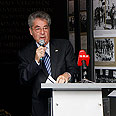
Vienna memorial for Nazi victims unveiled
Dedicated not only to Jewish victims but also to resistance fighters, remembrance site includes small exhibit that shows how Gestapo officials often used torture to torment those they summoned
The remembrance site is situated in the heart of Vienna, the Austrian capital, where a luxury hotel once stood that served as a coordination center for the Gestapo, Adolf Hitler's secret police.
Dedicated not only to Jewish victims but also to resistance fighters, it includes a small exhibit that shows how Gestapo officials often used torture to torment those they summoned and notes how the feared force was fed information from spies and informants in the Austrian population.
"The fates of thousands of people were decided here," Austrian President Heinz Fischer told a small crowd. "Thousands became victims of torture and often sent from here to concentration camps."
"Never Forget!" is written across the rear of the small space that used to be the back entrance of the Gestapo center. Leading to it are footprints that, according to Fischer, symbolize the helplessness of the men and women who walked through the dreaded doors.
Wedged between a tanning salon and a video rental store, the memorial originally opened in 1968 but was closed for a makeover.
The exhibit, consisting of a series of panels with photos and documents, also focuses on some of those who had the courage to confront Hitler and his followers.
One of those portrayed is Jacob Kastelic, a resistance fighter who was executed on Aug. 2, 1944.
His son, 71-year-old Gerhard who was not even 4 years old when his father was killed, said he hoped the memorial would help today's youth realize that, during a dark time in Austria's history, there were individuals who had the courage to stand up for their convictions.
"It's a way to show young people that while many Austrians at the time were, unquestionably, perpetrators... there was also resistance," he told The Associated Press.
Austria became part of a Greater Germany on March 12, 1938, when Wehrmacht troops crossed into the country to ensure a smooth takeover. Just days after "Anschluss," Hitler basked in the adoration of nearly 200,000 in a downtown Vienna square.
- Follow Ynetnews on Facebook










